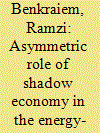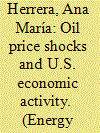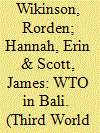| Srl | Item |
| 1 |
ID:
162972


|
|
|
|
|
| Summary/Abstract |
This paper estimates the energy demand function to examine the asymmetric relationship between the shadow economy and energy consumption in the case of Bolivia during the period of 1960–2015. The ambiguous empirical findings on shadow economy-energy demand nexus has inclined us to apply the nonlinear ARDL cointegration approach developed by Shin et al. (2014) and the Hatemi-J (2012) asymmetric causality test. The empirical evidence confirms the presence of an asymmetric relationship between the variables of interest. Positive and negative shocks to official GDP (true GDP) and the shadow economy have positive impacts on energy consumption. Energy consumption is positively and negatively affected by positive and negative shocks in financial development, respectively. A positive (negative) shock to capital decreases energy consumption. Another important finding concerns the complex causal direction between economic growth and energy consumption. This study provides new insights regarding to the use of official GDP (true GDP) and the shadow economy as economic tools to maintain energy demand for sustainable economic development.
|
|
|
|
|
|
|
|
|
|
|
|
|
|
|
|
| 2 |
ID:
166449


|
|
|
|
|
| Summary/Abstract |
Our understanding of the sources of oil price fluctuations and their effects on the U.S. economy has undergone important transformations in the last decades. First, several studies have demonstrated the importance of identifying the causes of oil price fluctuations, whether they are driven by demand or supply shocks, instead of assuming that oil price changes are exogenous to the evolution of the world's economic activity. Second, new methodologies have allowed researchers to re-evaluate the functional form of the relationship between oil prices and U.S. GDP, its components and job flows. Third, significant advances have been made in understanding the relationship between oil price uncertainty, news, economic policy uncertainty and aggregate economic activity. Finally, investigations into the time-varying nature of oil price-macroeconomy relationship have provided important insights into the reasons why unexpected increases in oil prices appear to shock less now than in the 1970s. This paper reviews the studies that have contributed to these different aspects of the literature.
|
|
|
|
|
|
|
|
|
|
|
|
|
|
|
|
| 3 |
ID:
139381


|
|
|
|
|
| Summary/Abstract |
The past two decades have witnessed a significant intensification of the bilateral relations between Spain and China that, in spite of the economic and political significance for the former, has received little scholarly attention. This essay explores the evolution of this relationship and its main dimensions. In addition, the essay analyzes the asymmetries and challenges the relationship raises. It argues that the growing influence of Beijing in the Mediterranean is not happening at the expense of Spain or other Southern European countries—the Asian giant has been able to create its own space within the region. In addition, this trend should be perceived by Madrid, Rome, or Athens not as a threat to their traditional privileged positions but as an opportunity.
|
|
|
|
|
|
|
|
|
|
|
|
|
|
|
|
| 4 |
ID:
135056


|
|
|
|
|
| Summary/Abstract |
The conclusion of the World Trade Organization’s (wto) ninth ministerial meeting – held in Bali 3–7 December 2013 – is at one and the same time momentous, marginal and business-as-usual. It is momentous because it marks the first multilateral agreement reached in the wto since the organisation began operations on 1 January 1995; it is marginal because the deal reached will have only a limited impact on the global trading system; and it is business as usual because the Bali package will be of disproportionally greater value to the industrial states than to their developing and least developed counterparts. We examine what happened in Bali, covering the principal issues at stake and the content of the outcome, what this means for the wto and for the Doha Development Agenda (dda), and why it all matters. We argue that, while the Bali ministerial is significant and the agreements reached important, the conclusion of the meeting and the package agreed represent only a limited movement forward in addressing the fundamental problems and inequities of the wto system.
|
|
|
|
|
|
|
|
|
|
|
|
|
|
|
|